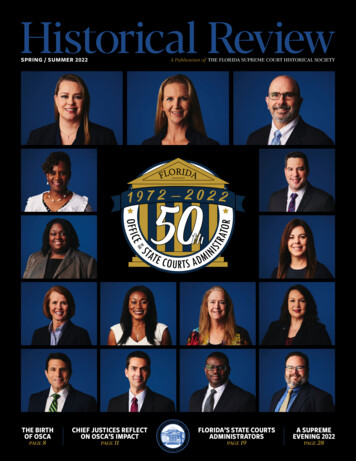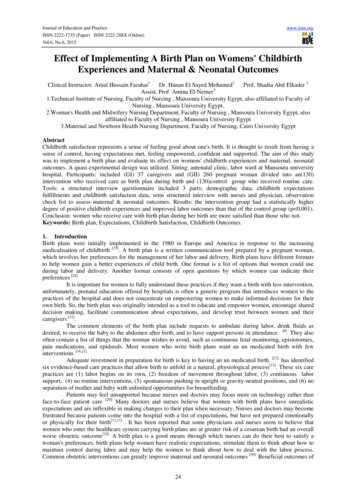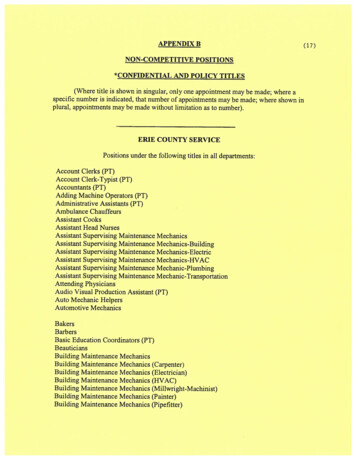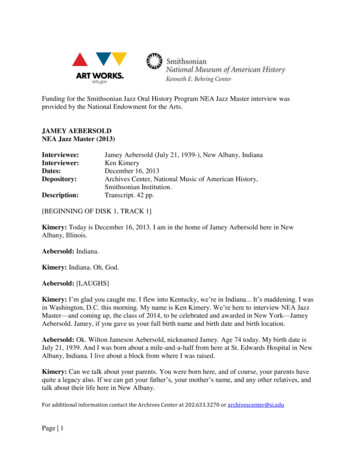
Transcription
SPRING / SUMMER 2022THE BIRTHOF OSCAPAGE 8A Publication of THE FLORIDA SUPREME COURT HISTORICAL SOCIETYCHIEF JUSTICES REFLECTON OSCA’S IMPACTPAGE 11FLORIDA’S STATE COURTSADMINISTRATORSPAGE 19A SUPREMEEVENING 2022PAGE 28
Contents61926Celebrating OSCAFlorida’s State CourtsAdministrators:1972-2022The Investitureof the HonorableJamie R. GrosshansMESSAGE FROMTHE CHIEF JUSTICEFLORIDA LEGAL HISTORYChief JusticeCharles T. CanadyJosie Follick8FLORIDA LEGAL HISTORYOSCA: Out of theBasement and Intothe Center of EveryFlorida CourtPatsy Palmer & Debbie Howells11FLORIDA LEGAL HISTORYPast Chief JusticesReflect on OSCA’sInfluence DuringTheir Tenures15OSCA Fromthe Inside: UnitDescriptionsSophia Akel & David Melito2128The Impact ofRevision 7 onFunding State CourtsSat Cito Si Recte:A SupremeEvening 2022FLORIDA LEGAL HISTORYDr. Steven R. MaxwellHISTORICAL SOCIETY EVENTSFrancine Walker2331Justice Muñiz toServe as the NextChief JusticeHistoricalSociety’s LifetimeAchievement AwardRenamed to HonorLongtime TrusteeFLORIDA SUPREME COURT NEWS24FLORIDA SUPREME COURT NEWSFLORIDA SUPREME COURT NEWSFLORIDA SUPREME COURT NEWSThe Investitureof the HonorableJohn D. CourielD. Bailey HowardJosie FollickHISTORICAL SOCIETY EVENTSFrancine Walker32HISTORICAL SOCIETY EVENTSJustice Major B.Harding Honoredfor a Lifetime ofAchievementMark D. KillianCOVER PHOTOSFIRST ROW: State Courts Administrator Ali Sackett, DeputyState Courts Administrator Katie Cunningham, Deputy StateCourts Administrator Eric Maclure SECOND ROW: GeneralCounsel C. Erica White, Office of Family Courts Chief JohnCouch THIRD ROW: Office of Legislative Affairs ChiefTashiba Robinson, Office of Problem-Solving Courts ChiefJennifer Grandal FOURTH ROW: Communications OfficeDirector Susan Emmanuel, Finance & Accounting ChiefJackie Knight, Court Education Chief Rose Patterson, BudgetServices Chief Sharon Bosley FIFTH ROW: AlternativeDispute Resolution Chief Tad David, Office of Court ServicesChief Andrew Johns, State Courts Technology OfficerRoosevelt Sawyer, Jr., General Services Chief Steven Hall2HISTORICAL REVIEWSPRING/SUMMER 2022
EDITOR’S MESSAGEWelcome to the June2022 issue of theHistoricalReview.And, happy 50th anniversaryto the Office of the State CourtsAdministrator, which we all knowas OSCA!It has been a thrill to see eachissue come to life since themagazine first introduced themed Photo by The Workmansissues in June 2020 with the wearetheworkmans.comredesign and celebration of TheFlorida Bar’s 70th anniversary.In this issue, we celebrate everything OSCA and its crucialrole in supporting Florida’s court system. First, an overview ofOSCA’s growth since inception. Then we hear from former chiefjustices of the Supreme Court of Florida on how OSCA aidedthem in their roles as chief. We also hear from the unit chiefsfrom within OSCA. Of course, we have also some history—with articles on the former State Courts Administrators and thelegislation that gave us OSCA.In other news, this issue covers the Court’s election of JusticeCarlos Muñiz as Florida’s 57th chief justice, recent Investitureceremonies, and the Society’s annual dinner that returned inperson in April 2022.I hope you enjoy!Florida Supreme CourtHistorical SocietySPRING/SUMMER 2022EDITORMelanie KalmansonEDITORIAL ASSISTANCESophia Akel Tim ChinarisPaul Flemming David MelitoPatsy PalmerDESIGN & LAYOUTCOVER PHOTOGRAPHYPUBLISHED BIANNUALLY BY THEFLORIDA SUPREME COURTHISTORICAL SOCIETYMark A. Miller, Executive Director1947 Greenwood Drive, Tallahassee, Florida 32303www.flcourthistory.org admin@flcourthistory.orgMelanie Kalmanson, Esq., EditorQUARLES & BRADY LLP TAMPA, FLORIDADISCLAIMERThe Florida Supreme Court Historical Society is a non-partisan,non-profit organization that supports free speech and the expressionthereof. The views and opinions expressed in this magazine are solelythose of the original authors and contributors and do not necessarilyreflect the views of the officers, trustees, and staff of the HistoricalSociety, the Florida Supreme Court or any affiliated entity.The Florida Supreme Court Historical Societyworks to save and maintain for future generationsthe records of the people and events that haveshaped the evolution of Florida’s court systemfrom the early 1800s, through the 21st Century,and beyond. The Society is committed to makingsure people understand the importance of a strong,independent judiciary in our governmental balanceof power. The Society’s two-fold mission is to (1)educate the public about the critically importantwork of the courts in protecting personal rightsand freedoms, as well as in resolving the myriad ofdisputes that arise within the state, and (2) preservethe rich history of Florida’s judicial system.This publication has been sponsored by the membersof the Florida Supreme Court Historical Society.F L O R I DA S U P R E M E C O U RT H I S T O R I C A L S O C I E T Y3
CONTRIBUTORSSophia AkelD. Bailey HowardMark D. KillianSophia Akel is a 2L at the FloridaState University College of Law.She received her Bachelor’s fromFSU with majors in Philosophy andEconomics. Through FSU Collegeof Law, Sophia serves as an editingintern for the Historical Review.Historical Society TrusteeD. Bailey Howard is an appellateattorney with Bishop & Mills, PLLC,in Tallahassee and a member of theFlorida Supreme Court HistoricalSociety Board of Trustees.Mark D. Killian is the editor ofThe Florida Bar Journal & News.Josie FollickDr. Steven R. MaxwellDebbie HowellsDavid MelitoDavid Melito is a third-year dualdegree candidate pursuing a JurisDoctor and a Master’s Degree inurban and regional planning atFlorida State University. David isa Florida native who has enjoyedworking in several levels of Floridagovernment. He currently splits histime between the City of TallahasseeAttorney’s Office and the Office ofthe State Courts Administrator.Patsy PalmerJosie Follick is a professionalwriter at the Office of theState Courts Administrator inTallahassee. She graduated magnacum laude from Florida StateUniversity in 2018 with a Bachelor’sdegree in political science andEnglish. She is currently attendingthe University of Florida, whereshe will earn a Master’s in masscommunications later this year.Debbie Howells is a courtoperations consultant in the Officeof the State Courts Administrator.She has been with the StateCourts System for more than 30years. During that time, she hasserved as the judicial assistantto Justice Rosemary Barkett aswell as in various positions in theadministrator’s suite. Her currentduties include serving as thestatewide ADA coordinator forthe courts, conducting researchand special projects, coordinatingcourt committee appointments, andsupporting court system meetings.Historical Society TrusteeDr. Steven R. Maxwell hasworked more than 35 years in stateand local government, education,and public affairs broadcasting.He has served as a public memberon both the Florida JudicialQualifications Commission and theFlorida Board of Bar Examiners(FBBE). He continues to serve asan emeritus member for the FBBEas well as a member of The FloridaBar’s Statewide Unlicensed Practiceof Law Committee.Historical Society TrusteePatsy Palmer is a lawyer inTallahassee and a member of theFlorida Supreme Court HistoricalSociety Board of Trustees.Francine WalkerFrancine Walker retired asDirector of Communications forThe Florida Bar in 2021, a positionshe held since 2000.4HISTORICAL REVIEWSPRING/SUMMER 2022
From the PresidentThis spring was a noteworthy seasonfor the Florida Supreme CourtHistorical Society. We hosted ourSupreme Evening event, which wasonce again live following last year’s virtualversion. The event was also three months laterthan the traditional January date followingthe Omicron variant outbreak of COVID19in December. Despitethe delay, A SupremeEvening was just that,and the theme wechose seemed apropos:“Sat Cito Si Recte,” theFlorida Supreme Courtseal’s Latin inscription,which those betterversed in classics thanI am report translatesas “soon enough if donerightly.” April 7 provedsoon enough, and thosewho attended agreedthat it was done rightlyindeed.At this year’s A Supreme Evening, theHistorical Society bestowed its LifetimeAchievement Award upon retired Justice MajorB. Harding, who accepted the award with hisfamily present and whose gracious acceptancespeech emphasized their role in his long,successful career. We also announced that theSociety has renamed the Lifetime AchievementAward in honor of our late colleague on theBoard of Trustees and generous longtimebenefactor, Susan Rosenblatt. Susan’s husbandStanley, accompanied by two of their children,gave heartfelt remembrances of Susan’s life asa champion of justice, wife, and mother. Ourkeynote speaker, Chief Justice Nathan L. Hechtof the Texas Supreme Court, known nationwideby his peers for his publicpromotion of the judiciaryin American life, gaveinspirationalremarksabout the headwindsfacing the third branchof government today andwhat we as lawyers andcitizens can do in responseto these challenges.In addition to coveringrecent events, this issuecelebratesthe50thanniversary of OSCA, theOffice of the State CourtsAdministrator. In addition,outgoing Chief JusticeCanady hands the gavel to incoming ChiefJustice Muñiz, who will take his turn as theleader of the Florida judiciary. Enjoy this issue,which I trust you will find arrives soon enough,and is done rightly.Sincerely,Scott R. Rost, PresidentFLORIDA SUPREME COURTHISTORICAL SOCIETYF L O R I DA S U P R E M E C O U RT H I S T O R I C A L S O C I E T Y5
MESSAGE FROM THE CHIEF JUSTICECelebratingOSCABy Chief Justice Charles T. CanadyFlorida’s judiciary entered its modern era 50years ago after voters approved a constitutionalamendment to unify our state courts and createa governance structure that is still in placetoday in largely the same form as it was implementedoriginally. Those reforms made the chief justice of theFlorida Supreme Court the top administrative officer ofthe state’s judicial branch.This is more than an academic discussion to me. I havehad the privilege of serving three terms as chief justice. Ican tell you that serving as chief justice would be a nearlyimpossible job without the aid of the Office of the StateCourts Administrator and the person who leads it—theState Courts Administrator.In particular, I appreciate one of those State CourtsAdministrators while recognizing the contributions ofall of those who have served in that role.In my first term as chief justice from 2010-2012, I hadthe benefit of working with Lisa Kiel as State CourtsAdministrator. I was further blessed to have her returnto that role in 2019 during my second term. Now, as Iconclude my third term, I am pleased to work with AliSackett, the eighth State Courts Administrator, at the6HISTORICAL REVIEWSPRING/SUMMER 2022beginning of her career.Lisa’s career in Florida’s court system has beenextraordinary. Lisa has repeatedly guided our courtsystem through challenging times—including theimplementation of a constitutional restructuring of courtfunding, a devastating fiscal crisis, and, most recently,the emergency conditions brought on by the pandemic.Time and again she demonstrated extraordinaryleadership and excellence in judicial administration. Shefulfilled her duties with exceptional professionalism andexceptional dedication to the judicial branch.It has been the great good fortune of Florida’s judicialbranch that Lisa dedicated her life to the work of judicialadministration in Florida.Lisa’s vision as State Courts Administrator was rootedin a clear understanding of the mission of the judicialbranch—to provide equal justice to all the litigants whocome to our courts. It is shaped by a deep knowledgeof sound principles of judicial administration and anappreciation of the interconnections of the various partsof the justice system.Lisa’s respect for colleagues shines through ineverything she does. Court systems operate in a
complex environment. They involve interactions notonly with court system users, judges, staff, and justicesystem partners, but also with the legislative andexecutive branches. Lisa has the ability to understandthe perspectives of all these different players and tofashion solutions that bring people together to furtherthe objective of strengthening the judicial branch’s abilityto provide justice. These are qualities of huge value to anychief justice.Lisa’s love for Florida’s judicial branch was strikinglydemonstrated when she came out of a very happy andrewarding retirement to help Florida’s courts through anunexpected transition in the position of the State CourtsAdministrator in 2019. Then I was able to convince Lisa,when the pandemic came, to extend her service to helpguide us through the crisis.During all my time in public service, I have neverknown a public servant who has served the public moreeffectively or with greater distinction than Lisa Kiel.Lisa certainly set the bar high. I know Ali is confidentand able and a worthy successor to Lisa. She will servewell as the eighth State Courts Administrator.The other members of the Court and I have welcomedAli to this vital role within the judicial branch and lookforward to her leadership. She comes to the position aftera successful career at The Florida Bar, most recently asdirector of the Legal Division, a position she held formore than 2 of her 14 years as a valued staff leader atthe Bar.She leads more than 175 employees in the Office of theState Courts Administrator. OSCA and its people workwith judicial officers and staff in jurisdictions throughoutthe state, doing some of the unsung work necessary forjustice to be done and disputes to be resolved in ourstate’s courts.As State Courts Administrator, Ali has led the StateCourts System successfully through her first legislativesession. My successor, Justice Muñiz, already understandsthe important role OSCA plays, as do all of us on theCourt. Soon he will have a new appreciation for the vitalhelp he will get from Ali to fulfill his responsibility, as doall of us who have had the privilege of leading the state’scourts as chief justice.F L O R I DA S U P R E M E C O U RT H I S T O R I C A L S O C I E T Y7
FLORIDA LEGAL HISTORYOSCA: Out ofthe Basement andInto the Center ofEvery Florida CourtBy Patsy Palmer and Debbie HowellsThis year, Florida marks half a century of amodern and well-managed court system.Fifty years ago, the state’s third branch ofgovernment was arguably its weakest, withthe court system still constitutionally identified as a“department” and a sprawling hodgepodge of stateand local courts that lacked adequate administrativecapacity or institutionalized central direction. Thatwould change dramatically in March 1972, when votersapproved sweeping reforms of Article V of the FloridaConstitution—the section that creates the judiciary.Those reforms not only streamlined and unified thestate courts, but centralized administrative power in theFlorida Supreme Court, with the chief justice designatedas chief administrative officer of the entire state courtssystem. The Florida Legislature quickly supportedthat authority by establishing the Office of State CourtAdministrator (OSCA) under the high court, somethingthen-Chief Justice B.K. Roberts had long championed.The initial, five-person OSCA office opened on July 1,1972, in the Court’s sub-basement.The legislation creating OSCA was just the beginning,A Timeline of the Number of Judges in Florida Courts 1972-20231200100080060040020001972-731974-75Total Judges8HISTORICAL REVIEW1976-77Circuit Court JudgesSPRING/SUMMER 20221978-791980-81County Court Judges1982-831984-851986-87District Court of Appeal Judges1988-89
In April 2022, OSCA staff gather in the courtroom at the Supreme Court of Florida in Tallahassee, Florida, for a group photo. OSCA’s staff now consists of nearly 200 members, up fromjust five when OSCA was formed. Group photos have become a tradition for OSCA staff.PHOTO BY THE WORKMANSand OSCA as we know it today was likely impossibleto conceptualize at the time. But OSCA’s earliestwork—developing a uniform case-reporting system—helped transform Florida’s judiciary into a modernand accessible system. More precise case reporting alsoenabled the Court to develop systemwide operatingbudget proposals and pinpoint the need for new judgesas caseloads grew.The OSCA concept—centralized administration ofthe Florida judiciary, based in Tallahassee—was metwith some initial resistance from court clerks and localadministrators, but OSCA’s authority steadily expandedas judges at all levels realized it freed them “to concentrateon adjudicatory, rather than administrative, tasks.”It did not take long for OSCA to outgrow the subbasement of the Supreme Court building. However,keeping up with Florida’s rapidly expanding court systemwas a challenge exacerbated by antiquated technology.Even in the mid-1980s, the approximately 60 OSCAemployees shared just four phone lines. Today, OSCA hasnearly 200 employees (almost all of whom have individualcomputers), whose responsibilities include serving 71998-992000-012002-032004-052006-07Source: Historic Statewide Judgeships, OSCA, tatistics/Historic-Statewide-JudgeshipsF L O R I DA S U P R E M E C O U RT H I S T O R I C A L S O C I E T Y9
system liaison for the legislature and the executive branch,as well as for national organizations; developing andrunning judicial and staff training programs; providingresearch and technical assistance to courts throughoutthe system; and working in areas like alternative disputeresolution, to expand access to justice. OSCA continues toproduce the annual budget proposals and project the needfor new judges and specialized court divisions.Additionally, turf wars over control have largely subsided,in part through bridge-building efforts by the late ChiefJustice Ben F. Overton and former OSCA AdministratorJack Harkness. The Constitution, Florida Statutes, andrules allow some level of local control under OSCA’sadministrative umbrella. Each of the twenty circuit courtshas its own trial court administrator working with the chiefjudge of the circuit, while individual clerks and marshalsassist each chief judge of the five district courts of appealwith administrative matters. Local court administratorsand clerks have worked jointly with OSCA on projects likee-filing and the e-portal.OSCA has developed into a critical part of theadministration of Florida’s court system. Undoubtedly, itsrole will continue to develop over the next 50 years.For ease of publication and reading, footnotes have beenremoved from this article. The full version, with footnotes,may be viewed on the Historical Society’s website at Articles.For further perspective on OSCA over theyears, see Reflections on Changes in CourtAdministration Since 1972: In Celebration ofOSCA’s 40th Birthday, which can be found tions/Short-History/Miscellany.TOP: Before Florida’s courts transitioned to operating in a largely paperless environment,it was a more paper-intensive era. Here, OSCA staff member Laverne Weeks is at her deskin the sub-basement of the Supreme Court Building.BOTTOM: Long-time OSCA receptionist Mary Keuchel works to organize all of OSCA’spaper records.A Timeline of the Number of Judges in Florida Courts 1972-2023 (Cont.)1200100080060040020002006-072008-09Total Judges10HISTORICAL REVIEW2010-112012-13Circuit Court JudgesSPRING/SUMMER 20222014-15County Court Judges2016-172018-192020-21District Court of Appeal Judges2022-23
FLORIDA LEGAL HISTORYPast Chief JusticesReflect on OSCA’sInfluence DuringTheir TenuresOne critical role OSCA plays in ensuring the smooth operation of Florida’s courtsystem is supporting the chief justice. As chief administrative judge for the entirestate, the chief justice requires administrative support in areas as diverse as budgeting,facilities review, and projecting the need for new judgeships. Below, several formerchief justices weigh in on how OSCA supported them during their terms as chief.July 1, 1992 – First day on the job as C.J.; Awakened at 3:00 AMby Ken Palmer telling me there was no budget! [We] stayed up andworked on the attached Order (Released at 9:00 AM) – What away to start!Chief Justice Rosemary Barkett1992-1994It is hard to believe that OSCA is turning 50! Being askedto write a few words about my time with OSCA brought backmany wonderful memories. I remember Ken Palmer, who wasthe State Courts Administrator when I took over as chief, withgreat fondness. He was such a wonderful administrator and anincredibly hard worker. My first day as chief justice providedample evidence of the dedication of the OSCA staff, led by Ken,as they spent every day, and most nights, in the legislative hallstrying to assure that the judiciary would be funded. My diary formy first day as chief reads as follows:The Order Ken and I crafted (“In Re Emergency Operationof the Judicial Branch”) decreed that the courts would remainopen and that the state government would remain responsiblefor all costs connected therewith, leaving no question that thecourts would remain open, notwithstanding the temporarybudget crisis.From that day forward, I was able to observe the amazingwork of Ken and his team in so many areas. Along with the lateDee Beranek, former Deputy State Courts Administrator, Kenand the OSCA team developed and operated a first-rate JudicialCollege responsible for training so many judges. Ken helpedme in areas involving children and families by working withme to organize a statewide conference of chief judges and StateCourts Administrators to advance the goal of a unified familycourt in all of the circuits. OSCA helped in the effort to requirethe Department of Children and Families to identify all of thechildren in their custody. (Amazingly, the Department had nosuch list, and I wonder if they have one now!)In this day and age, the judicial branch is tasked with somuch more than simply deciding cases. The administration ofthe court system is now a tremendous responsibility and couldnot be accomplished without the support of the extremelycapable leadership and staff of the Office of the State CourtsAdministrator.F L O R I DA S U P R E M E C O U RT H I S T O R I C A L S O C I E T Y11
Chief Justice Harry Lee Anstead2002-2004Chief Justice Barbara J. Pariente2004-2006The Chief Justice is the administrative head of Florida’scourt system, but OSCA is the office that carries out theadministration on a day-to-day basis by providing extensivesupport for Florida’s trial and appellate courts, including theFlorida Supreme Court. Since Florida is the nation’s third largeststate, that is an enormous responsibility. No one does it betterand more professionally than Florida’s OSCA. Making sure thatour courts have all the resources that a modern court systemrequires is a 24/7 task and that is how OSCA operates, andalways has.A prime example of OSCA’s quality work is its operation ofFlorida’s judicial education system, which ranks number 1 inthe country. From courses on the fundamentals of judging andjudicial conduct for the wave of new judges that come on thebench every year, to the critically important and super-sensitiveduties of a judge presiding over a capital case, Florida’s judgesare provided with cutting-edge and up-to-date insight oncurrent law and procedures. And that is just one example ofOSCA’s job performance.What is my opinion of OSCA’s overall job performance? In aword, OSCA and its members are the best, bar none.On the 50th anniversary of the Office of the State CourtsAdministrator—otherwise known as OSCA, I salute the entirestaff of dedicated professionals who have made Florida’s courtsystem a model of court administration for many other states.While so much of what OSCA does is behind the scenes to mostlawyers, every judge in this State, every chief judge, and each ofthe Trial Court Administrators of the 20 judicial circuits knowthe invaluable place OSCA plays in running a modern courtsystem.As for the justices of the Supreme Court of Florida, andparticularly those of us who have served as chief justice, weknow that our accomplishments would not be possible withoutOSCA. As chief justice of the then-fourth largest state in thecountry, there would have been no way to accomplish mygoals without this amazing group of stellar and hard-workingindividuals.During my time as chief justice, OSCA was headed up byState Courts Administrator Lisa Goodner (now Lisa Kiel).How Lisa remained calm under pressure from the hundreds ofjudges, the court administrators of each of the 20 trial courts,and the demands of each of the justices was always beyond me,but I know how fortunate I was to have Lisa and her staff forcritical support.During my term as chief, which began on July 1, 2004, thecourt system effectuated the mandate of statewide funding forthe court system. Required by a constitutional amendment thathad passed previously, the purpose of Revision 7 (as we referredto it) was to equalize the available resources of each circuit. Thegoal of the critical constitutional change was to ensure that theresources of each circuit would not depend on which chief judgehad the best legislative relations, but instead on objective factorsapplied equally across the state. I characterized the benefits ofthe constitutional change as ensuring that, from Key West toPensacola, there would no longer be “rich circuits” and “poorcircuits.”I was privileged to be the first chief justice to preside overa truly unified court system—but to realize that vision andput it into effect required the work of literally dozens ofindividuals, both in Tallahassee and around the state. Withoutthe meticulous work of the Trial Court Budget CommissionCHIEF JUSTICES SINCEOSCA’S FORMATION IN 1972B. K. Roberts1971-1973Stephen H. Grimes1994-1996Vassar B. Carlton1973-1974Gerald Kogan1996-1998James C. Adkins, Jr.1974-1976Major B. Harding1998-2000Ben F. Overton1976-1978Charles T. Wells2000-2002Arthur J. England, Jr. 1978-1980Harry Lee Anstead2002-2004Alan C. Sundberg1980-1982Barbara J. Pariente2004-2006James E. Alderman1982-1984R. Fred Lewis2006-2008Joseph A. Boyd, Jr.1984-1986Peggy A. Quince2008-2010Parker Lee McDonald 1986-1988Charles T. Canady2010-2012Raymond Ehrlich1988-1990Ricky Polston2012-2014Leander J. Shaw, Jr.1990-1992Jorge Labarga2014-2018Rosemary Barkett1992-1994Charles T. Canady2018-202212HISTORICAL REVIEWSPRING/SUMMER 2022
(TCBC) and the daily support of OSCA, the transition wouldhave been impossible.Under OSCA’s guidance, each chief justice is charged withcarrying out a strategic plan that is reduced to writing forguidance. My top 3 priorities were to continue to ensure full andfair funding of the courts, to take advantage of the opportunitiesthat new technologies have created, and to encourage trialcourts to implement the unified family court model. While eachof the circuits has its own court administrator and staff, OSCAhelps to oversee the sound policies that are promulgated by theSupreme Court of Florida.During my tenure, I was especially privileged to work withdedicated individuals from the various departments of OSCA,particularly those charged with improving the processing ofdependency cases, those charged with court education for ourjudges and court staff, and those charged with supporting themyriad court committees such as the Committee on Childrenand Families. With my particular interest in cases involvingchildren and families, I traveled the state with the help of OSCAto speak with chief judges and court personnel to ensure that Ireceived their input on how our policies were being implementedat the local level.As I think back on my two years as chief justice from July1, 2004, to July 1, 2006, I am reminded how many of thehighlights of my time in that position were connected with theextraordinary men and women of OSCA!Chief Justice Peggy A. Quince2008-2010As a justice on the Florida Supreme Court, I interacted withthe Office of the State Courts Administrator (OSCA) on almosta daily basis. Each individual division of that office, frompersonnel to dispute resolution to budget and finance, played avital role in making sure that the Florida court system operatedin an efficient and timely manner. During my term as chiefjustice, I relied on the State Courts Administrator to keep meinformed on the various issues that were of concern in any partof the system, in any part of the state. OSCA is the glue thatkeeps the Florida court system together.Chief Justice Ricky Polston2012-2014My term as chief justice from July 1, 2012, to June 30, 2014,came at a particularly useful time to describe the vital roleplayed by the relationship between the chief justice and the StateCourts Administrator.Gaining adequate resources for the administration of justice—and the careful stewardship of those resources—is alwaysat the forefront of a chief justice’s responsibility. Reliable andtimely court data is a vexing problem the State Courts Systemhas faced since the founding of the Office of the State CourtsAdministrator (OSCA). At the nexus of resources and data isthe question of technology and how to pay for it.In all these issues—each with specific challenges—a chiefjustice relies on the State Courts Administrator and OSCAstaff to provide necessary information and technical guidance.Then it is the State Courts Administrator who must faithfullyimplement the decisions and direction of the Florida SupremeCourt and the chief justice.In 2012 when I accepted the passing of the gavel as chief justicefrom Chief Justice Charles T. Canady following the conclusionof his first term as chief, I knew I would rely extensively on LisaKiel, the State Courts Administrator. The two largest challengesfacing us during my term were the foreclosure crisis andimmediately transitioning to
Sophia Akel is a 2L at the Florida State University College of Law. She received her Bachelor's from FSU with majors in Philosophy and Economics. Through FSU College of Law, Sophia serves as an editing intern for the Historical Review. Sophia Akel Josie Follick is a professional writer at the Office of the State Courts Administrator in .










